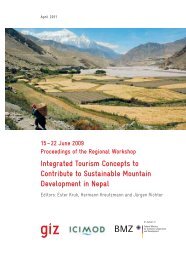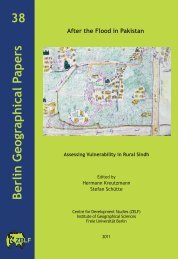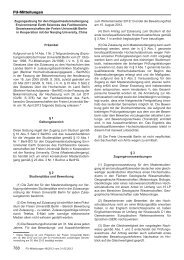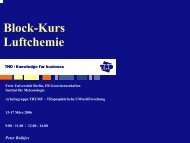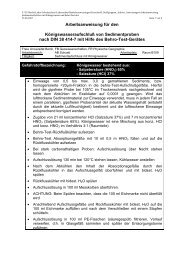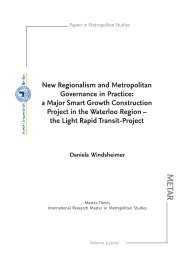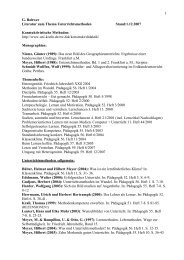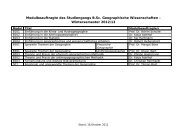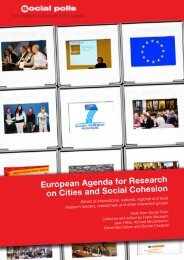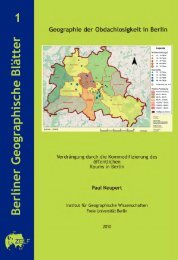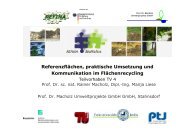Pastoralism and Rangeland Management on the Tibetan Plateau in ...
Pastoralism and Rangeland Management on the Tibetan Plateau in ...
Pastoralism and Rangeland Management on the Tibetan Plateau in ...
Create successful ePaper yourself
Turn your PDF publications into a flip-book with our unique Google optimized e-Paper software.
c<strong>on</strong>tributed largely by <strong>the</strong> native populati<strong>on</strong>. The issue of waste management is<br />
an urgent <strong>on</strong>e <strong>in</strong> many settlements.<br />
5 L<strong>in</strong>k<strong>in</strong>g Ecotourism with Rangel<str<strong>on</strong>g>and</str<strong>on</strong>g> <str<strong>on</strong>g>Management</str<strong>on</strong>g><br />
The spatial distributi<strong>on</strong> shows a good share <strong>in</strong> rangel<str<strong>on</strong>g>and</str<strong>on</strong>g>s <strong>in</strong> Upper Mustang<br />
<str<strong>on</strong>g>and</str<strong>on</strong>g> <strong>the</strong>re are still quite a number of local herders. The dry<strong>in</strong>g <str<strong>on</strong>g>and</str<strong>on</strong>g> chang<strong>in</strong>g<br />
climatic c<strong>on</strong>diti<strong>on</strong>s <str<strong>on</strong>g>and</str<strong>on</strong>g> <strong>the</strong> <strong>in</strong>creas<strong>in</strong>g scarcity of grasses <strong>in</strong> pastures imposes<br />
greater threats to local herders’ livelihoods. Thus tourism could possibly be<br />
a nice opti<strong>on</strong> to supplement <strong>the</strong>ir livestock herd<strong>in</strong>g. The nomadic lifestyle,<br />
<strong>the</strong> rangel<str<strong>on</strong>g>and</str<strong>on</strong>g> culture, <strong>the</strong> l<str<strong>on</strong>g>and</str<strong>on</strong>g>scape <str<strong>on</strong>g>and</str<strong>on</strong>g> <strong>the</strong> pastures, as well as traditi<strong>on</strong>al<br />
herd<strong>in</strong>g sites, can be developed as a tourist products. Livestock products such<br />
as milk <str<strong>on</strong>g>and</str<strong>on</strong>g> meat can be used <str<strong>on</strong>g>and</str<strong>on</strong>g> manufactured <strong>in</strong>to commercial food items<br />
such as cheese, butter, milk products, different meat items, pashm<strong>in</strong>a wool,<br />
woollen clo<strong>the</strong>s, etc. These products could provide a sum of m<strong>on</strong>ey that could<br />
significantly <strong>in</strong>crease <strong>the</strong> local herders’ <strong>in</strong>comes.<br />
5.1 Impact of Tourism <strong>on</strong> Rangel<str<strong>on</strong>g>and</str<strong>on</strong>g> Resources<br />
The tourism bus<strong>in</strong>ess <strong>in</strong> Lower Mustang is becom<strong>in</strong>g a part of <strong>the</strong> lives <str<strong>on</strong>g>and</str<strong>on</strong>g><br />
livelihoods of <strong>the</strong> people. However, this is not <strong>the</strong> same <strong>in</strong> Upper Mustang,<br />
which is still a so-called restricted area. From a rangel<str<strong>on</strong>g>and</str<strong>on</strong>g> resources po<strong>in</strong>tof-view<br />
this is ra<strong>the</strong>r beneficial, but as far as poor people are c<strong>on</strong>cerned <strong>the</strong><br />
real benefits from this sector do not go to <strong>the</strong>m. Currently, tourists <strong>in</strong> a group<br />
usually stay <strong>in</strong> big houses or hotels where camp<strong>in</strong>g facilities are available. Thus,<br />
<strong>the</strong> majority of <strong>the</strong> benefit goes to <strong>the</strong> people who run <strong>the</strong>se places. Additi<strong>on</strong>ally,<br />
tourism has made buckwheat, wheat, naked barley, dry forage (hay), etc.<br />
expensive for <strong>the</strong> poor.<br />
Despite all of this, <strong>the</strong>re are some positive possible impacts <strong>on</strong> rangel<str<strong>on</strong>g>and</str<strong>on</strong>g> resources<br />
<strong>in</strong> <strong>the</strong> l<strong>on</strong>g run. Such impacts could <strong>in</strong>clude a change <strong>in</strong> <strong>the</strong> livestock<br />
herd compositi<strong>on</strong> because people ma<strong>in</strong>ta<strong>in</strong> more productive animals for milk,<br />
meat, wool (pashm<strong>in</strong>a) <str<strong>on</strong>g>and</str<strong>on</strong>g> egg producti<strong>on</strong>, due to an <strong>in</strong>creased dem<str<strong>on</strong>g>and</str<strong>on</strong>g> from<br />
tourists. This would reduce <strong>the</strong> number of unproductive animals. Also, livestock<br />
herders can go for product diversificati<strong>on</strong> <strong>in</strong> an <strong>in</strong>tensive <str<strong>on</strong>g>and</str<strong>on</strong>g> commercial<br />
way; from low value, higher volume to high value, low volume. For example,<br />
<strong>the</strong>y can produce milk for cheese, butter, chhurpee (dried cheese), <str<strong>on</strong>g>and</str<strong>on</strong>g> work <strong>on</strong><br />
pashm<strong>in</strong>a producti<strong>on</strong> <str<strong>on</strong>g>and</str<strong>on</strong>g> process<strong>in</strong>g. Likewise, <strong>the</strong> climate of Mustang is best<br />
suitable for hay producti<strong>on</strong>, <str<strong>on</strong>g>and</str<strong>on</strong>g> <strong>the</strong>re is a high dem<str<strong>on</strong>g>and</str<strong>on</strong>g> for dried forage. This<br />
activity could take a commercial shape, even for those who do not have any<br />
livestock, as a bundle of hay weigh<strong>in</strong>g 1 to 2 kg can go for NRs 30.<br />
96



